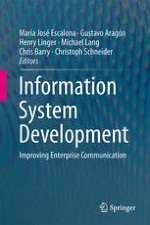2014 | OriginalPaper | Chapter
10. Using Process-Level Use Case Diagrams to Infer the Business Motivation Model with a RUP-Based Approach
Authors : Carlos E. Salgado, Ricardo J. Machado, Rita S. P. Maciel
Published in: Information System Development
Publisher: Springer International Publishing
Activate our intelligent search to find suitable subject content or patents.
Select sections of text to find matching patents with Artificial Intelligence. powered by
Select sections of text to find additional relevant content using AI-assisted search. powered by
